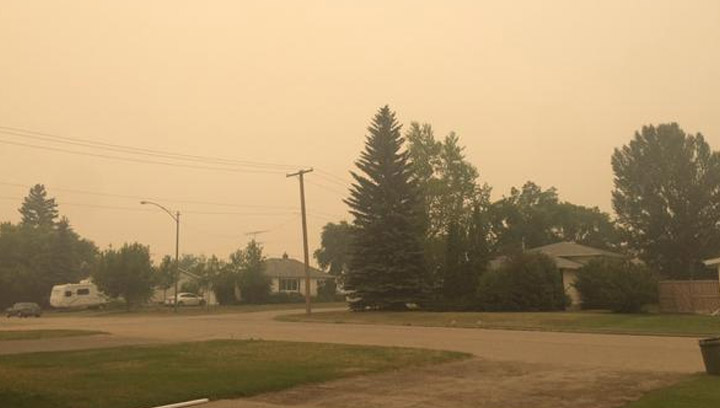WARNING: The above video shot by Angel Herraiz on June 28, 2015 contains language some may find offensive. It shows a wildfire along Highway 969 in northern Saskatchewan.

SASKATOON – Hot temperatures and low precipitation continue to fuel more than 100 wildfires across Saskatchewan. The smoke from the fires has lead Environment Canada to issue an air quality statement for most of the province, including Saskatoon and surrounding area.
Air quality is poor in many regions. The air quality health index in Saskatoon and Prince Albert is now at a very high risk of 10+ and is expected to remain in that range into Monday night.
UPDATE: Air quality health index remains at very high risk for all of Saskatchewan
Watch below: The effects of wildfires in the north are being felt province-wide as smoke drifts down. Meaghan Craig talks to the experts about air quality concerns and finds out what outdoor activities are being postponed as a result.
The Saskatchewan Ministry of Health has issued a level 2 air quality alert for the areas experiencing heavy smoke.
Outdoor physical activity should be reduced or avoided, with children and the elderly advised to avoid outdoor physical exertion. Officials say people with room air cleaners with HEPA filters should turn them on and all windows, doors and outdoor air circulation fans and vents should be closed.
People in vehicles should keep their windows closed and put their air system on recirculate.
READ MORE: Fort McMurray covered in haze as 125 wildfires burn across Alberta
MD Ambulance is cautioning asthma and respiratory patients to be on high alert and to stay indoors.
“If you do suffer from some sort of respiratory illness we are recommending you stay indoors today,” said MD Ambulance spokesperson Troy Davies.
“If you have to be outside ensure that you have your inhaler with you.”
Officials say other people should reduce or reschedule strenuous outdoor activities, especially those who experience symptoms such as coughing and throat irritation.
As of Monday morning, there were 115 active fires in Saskatchewan.
Visibility has been reduced to less than two kilometres in many areas, especially in central and northern Saskatchewan and is expected to persist over the next couple of days.
Some highways have been closed due to the fires, including portions of Highway 2 north of Highway 264 by Prince Albert National Park.
The Lac La Ronge Indian Band has declared a local state of emergency. Over 1,300 people have been evacuated from 14 communities, including Montreal Lake, Wadin Bay, Sucker River, English River, Nemeiben and Weyakwin.
Almost 700 of the evacuees had been brought to Saskatoon. The majority are being housed at Henk Ruys soccer centre, with some being put up in hotels and a few are staying with family and friends.
The remaining evacuees have been taken to Prince Albert or North Battleford or are staying with family or friends.
Watch below: Hundreds of residents in northern Saskatchewan have been forced to flee their homes because of raging wildfires. Wendy Winiewski finds out how the people staying in Saskatoon are coping and what you can do to help.
Stanley Mission is not under any fire threat, but due to heavy smoke conditions, people with chronic lung and heart conditions, pregnant women, elders and children under two are being moved south from the community.
All campgrounds at Lac La Ronge provincial park are closed with the exception of Nut Point. A fire ban remains in place until further notice, with no open fires allowed in any provincial forests or provincial parks and recreation sites within the forests.
READ MORE: Damaging effects of lightning in Saskatchewan
Officials with the Ministry of Environment said low humidity is triggering rapid fire movement at night, which is unusual. An infrared equipped aircraft from Ontario is being brought in to help crews battling the wildfires.
“To address that overnight fire movement, we are looking at bringing in a contracted resource that can do infrared scanning at night and give that info to our crews,” said Steve Roberts, the province’s executive director of wildfire management.
READ MORE: Manitoba skies darkened by Saskatchewan fires
Watch below: Crews continue to battle wildfires in northern Saskatchewan as more people evacuated. Amber Rockliffe reports.
With files from Amber Rockliffe










Comments